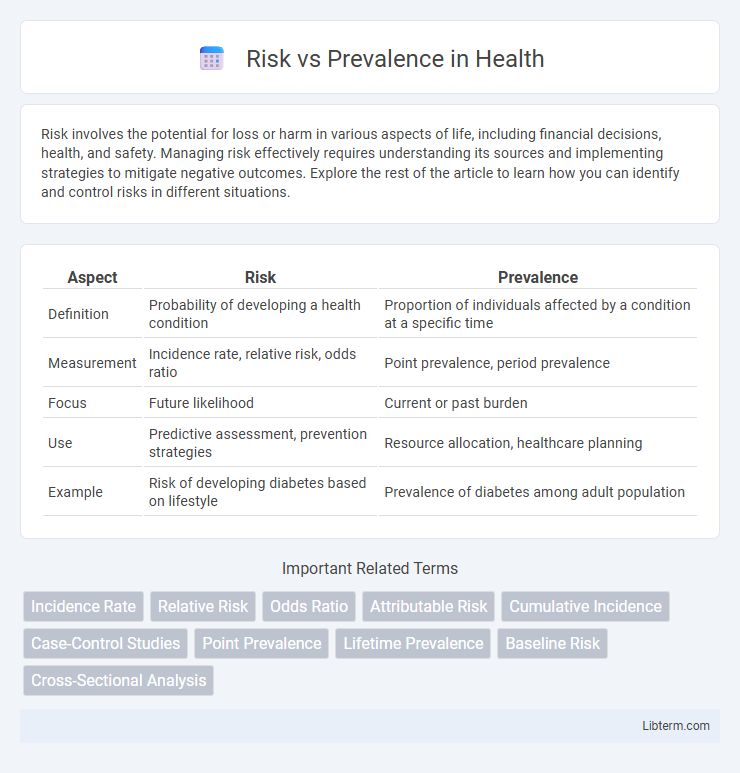Risk involves the potential for loss or harm in various aspects of life, including financial decisions, health, and safety. Managing risk effectively requires understanding its sources and implementing strategies to mitigate negative outcomes. Explore the rest of the article to learn how you can identify and control risks in different situations.
Table of Comparison
| Aspect | Risk | Prevalence |
|---|---|---|
| Definition | Probability of developing a health condition | Proportion of individuals affected by a condition at a specific time |
| Measurement | Incidence rate, relative risk, odds ratio | Point prevalence, period prevalence |
| Focus | Future likelihood | Current or past burden |
| Use | Predictive assessment, prevention strategies | Resource allocation, healthcare planning |
| Example | Risk of developing diabetes based on lifestyle | Prevalence of diabetes among adult population |
Understanding Risk and Prevalence: Key Differences
Risk quantifies the likelihood of developing a disease or condition over a specific period, often expressed as a probability or percentage, while prevalence measures the total number of existing cases in a population at a given time. Understanding risk involves evaluating factors that increase susceptibility, such as genetics or lifestyle, whereas prevalence reflects the burden of disease within a community or demographic. Differentiating between risk and prevalence is essential for public health planning, resource allocation, and designing targeted interventions.
The Importance of Distinguishing Risk from Prevalence
Distinguishing risk from prevalence is crucial for accurate public health planning and intervention strategies, as risk refers to the probability of developing a disease within a specific time frame, while prevalence indicates the total number of existing cases at a given point. Misinterpreting prevalence as risk can lead to overestimation of disease burden and misallocation of resources, potentially skewing prevention efforts. Understanding the difference enables more precise epidemiological assessments and better-targeted healthcare policies.
Factors Influencing Risk
Risk assessment depends heavily on factors such as genetic predisposition, environmental exposures, and lifestyle choices that affect the likelihood of developing a condition. Prevalence rates provide context by illustrating how widespread a condition is within a population, but understanding individual risk requires analyzing modifiable and non-modifiable influences. Epidemiological studies emphasize age, socioeconomic status, and comorbidities as critical determinants shaping risk profiles across different demographics.
Methods for Measuring Prevalence
Prevalence is commonly measured using cross-sectional studies that capture data on disease occurrence within a specified population at a single point in time, offering a snapshot of health status. Surveys, health registries, and medical records are essential sources for prevalence estimation, enabling comprehensive data collection to assess disease burden. Accurate measurement requires standardized definitions and diagnostic criteria to ensure consistency and comparability across populations and time periods.
Common Misconceptions About Risk and Prevalence
Risk refers to the probability of an event occurring within a specific period, while prevalence indicates the proportion of a population affected by a condition at a given time. A common misconception is treating high prevalence as synonymous with high individual risk, which ignores that prevalence measures existing cases, not the likelihood of developing the condition. Confusing these terms can lead to misinformed public health decisions and misunderstandings in clinical risk assessment.
Risk Assessment in Public Health
Risk assessment in public health quantifies the probability and potential impact of adverse health events to guide prevention strategies. It prioritizes resources by evaluating exposure levels, susceptibility, and population vulnerability, distinguishing risk factors from mere prevalence of disease. Accurate risk assessment informs targeted interventions, reducing morbidity and mortality more effectively than reliance on prevalence data alone.
Prevalence Trends Across Populations
Prevalence trends across populations reveal significant variations in disease occurrence linked to genetic, environmental, and socioeconomic factors. Epidemiological studies indicate rising prevalence rates in urban areas due to lifestyle changes and increased exposure to risk factors. Monitoring these trends enables targeted public health interventions and resource allocation to mitigate disease burden effectively.
The Role of Time in Risk vs Prevalence
Risk measures the probability of developing a disease over a specified period, reflecting the dynamic nature of exposure and time. Prevalence captures the proportion of individuals affected by a condition at a particular point or period, encompassing both new and existing cases. The role of time differentiates risk as a forward-looking metric sensitive to incidence rates, whereas prevalence represents a snapshot influenced by disease duration and survival.
Applications of Risk and Prevalence in Policy Making
Risk assessment quantifies the probability and impact of adverse events, guiding policymakers to prioritize resource allocation and design targeted interventions. Prevalence data, indicating the current burden of a condition within a population, informs the scale and urgency of public health initiatives. Integrating both risk and prevalence enables evidence-based decision-making that balances preventive measures with immediate healthcare needs.
Enhancing Awareness: Risk Communication and Prevalence Data
Effective risk communication leverages accurate prevalence data to enhance public understanding of health threats, enabling informed decision-making. Utilizing visual aids and clear messaging increases comprehension of risk levels correlated with disease frequency in populations. Tailored awareness campaigns based on demographic prevalence statistics improve the relevance and impact of risk communication efforts.
Risk Infographic

 libterm.com
libterm.com